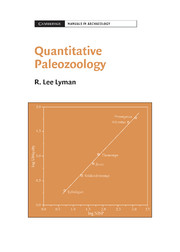Book contents
- Frontmatter
- Contents
- List of figures
- List of tables
- Preface
- 1 Tallying and Counting: Fundamentals
- 2 Estimating Taxonomic Abundances: NISP and MNI
- 3 Estimating Taxonomic Abundances: Other Methods
- 4 Sampling, Recovery, and Sample Size
- 5 Measuring the Taxonomic Structure and Composition (“Diversity”) of Faunas
- 6 Skeletal Completeness, Frequencies of Skeletal Parts, and Fragmentation
- 7 Tallying for Taphonomy: Weathering, Burning, Corrosion, and Butchering
- 8 Final Thoughts
- Glossary
- References
- Index
3 - Estimating Taxonomic Abundances: Other Methods
Published online by Cambridge University Press: 05 June 2012
- Frontmatter
- Contents
- List of figures
- List of tables
- Preface
- 1 Tallying and Counting: Fundamentals
- 2 Estimating Taxonomic Abundances: NISP and MNI
- 3 Estimating Taxonomic Abundances: Other Methods
- 4 Sampling, Recovery, and Sample Size
- 5 Measuring the Taxonomic Structure and Composition (“Diversity”) of Faunas
- 6 Skeletal Completeness, Frequencies of Skeletal Parts, and Fragmentation
- 7 Tallying for Taphonomy: Weathering, Burning, Corrosion, and Butchering
- 8 Final Thoughts
- Glossary
- References
- Index
Summary
In Chapter 2, the two methods of measuring taxonomic abundances – NISP and MNI – most commonly used in paleozoology were discussed. In this chapter other methods that have been used to quantify taxonomic abundances or what is sometimes loosely referred to as taxonomic importance are described. In so doing, perhaps methods that work better than NISP and MNI in some situations can be identified. And, we can explore how and why some of these methods are less accurate, valid, or reliable than NISP, MNI, or each other, and whether or not they should be used at all. This last point is critical because virtually all of the alternative methods discussed here have occasionally been advocated as better than NISP or MNI as measures of taxonomic abundances within a biocoenose. Because most of them were proposed 20 or more years ago, it seems appropriate to evaluate them in light of the new knowledge that has been gained over the past two decades.
The problems that attend NISP and MNI suggest that counting units different than MNI and NISP should be designed and used. And the literature contains arguments that counting units other than NISP and MNI should be used to determine taxonomic abundances. Clason (1972:141), for example, argues that MNI should be termed the “estimated minimum number of individuals,” and he uses the word estimated “intentionally because a real calculation of the minimum number of individuals is not possible.”
- Type
- Chapter
- Information
- Quantitative Paleozoology , pp. 83 - 140Publisher: Cambridge University PressPrint publication year: 2008



